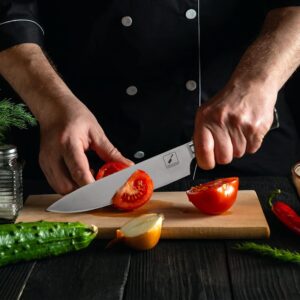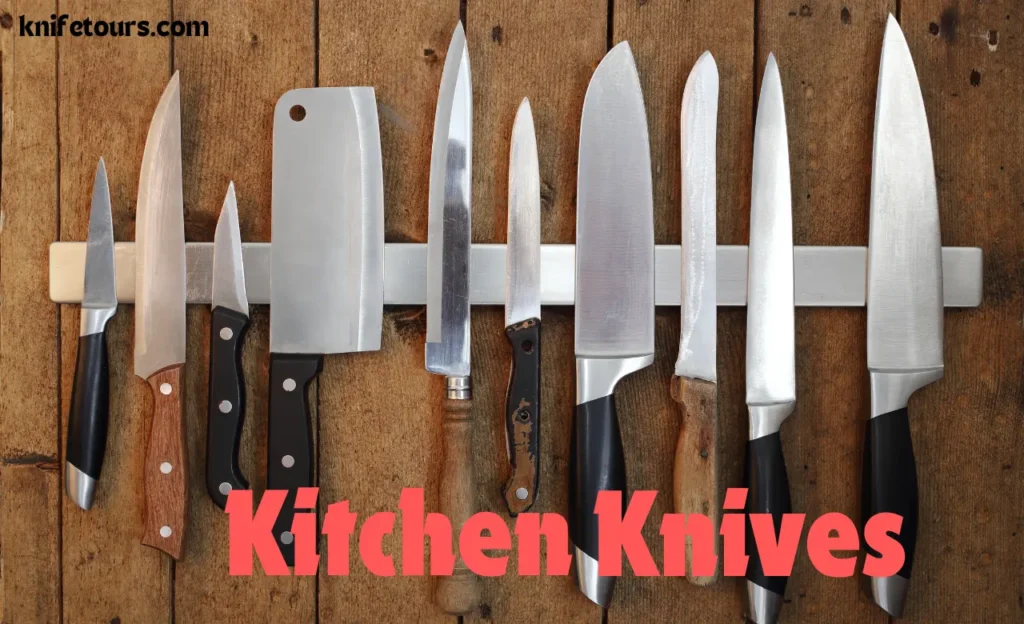When it comes to culinary arts, the importance of using the right type of knife for various kitchen tasks cannot be overstated. Each type of kitchen knife is designed with a specific purpose in mind, from dicing vegetables to slicing bread. The history of kitchen knives dates back to ancient times, evolving from basic cutting tools to the sophisticated and specialized varieties we see today. Understanding the different types of kitchen knives and their uses not only enhances your cooking skills but also ensures safety and efficiency in the kitchen. In this post, we will explore the most common types of kitchen knives, their unique characteristics, and how to choose the best one for your culinary needs.
Chef’s Knife
The chef’s knife, often considered the backbone of kitchen utensils, is a versatile tool suitable for a variety of tasks. Typically ranging from 6 to 12 inches in length, this knife features a broad, tapered shape with a fine sharp edge. It’s ideal for chopping, slicing, and dicing fruits, vegetables, meats, and herbs. The weight and balance of a chef’s knife allow for both fine precision work and heavier chopping tasks.
When choosing a chef’s knife, consider the blade material (such as stainless steel or carbon steel), handle comfort, and balance. A good chef’s knife should feel like an extension of your hand, providing control and comfort. Remember, the quality of your chef’s knife can significantly impact your cooking efficiency and enjoyment.

Paring Knife
The paring knife is the unsung hero of the kitchen, perfect for tasks that require precision. This small knife typically measures between 3 and 4 inches in length and features a plain edge blade. It’s ideal for peeling, trimming, and slicing small fruits and vegetables, as well as for detailed work like deveining shrimp or removing seeds.
When selecting a paring knife, look for a comfortable handle and a blade that maintains sharpness over time. The best paring knives offer agility and control, allowing for delicate and intricate cuts. A good paring knife complements the chef’s knife by handling tasks that require more finesse.
Utility Knife
The utility knife, often seen as a bridge between the chef’s knife and the paring knife, is a versatile and indispensable tool in the kitchen. Generally measuring between 4 to 7 inches, the utility knife has a narrower and straighter blade. It’s perfect for tasks that are too small for a chef’s knife but too large for a paring knife. This includes slicing medium-sized fruits and vegetables, sandwich meats, and cheese.
When choosing a utility knife, consider the blade type. Some utility knives come with a serrated edge, which is ideal for cutting through foods with a tougher exterior and soft interior, like tomatoes or sausages. A straight-edge utility knife, on the other hand, is great for more precise cuts. The utility knife is a handy tool for everyday tasks, offering a balance of precision and versatility.
Santoku Knife
The Santoku knife, originating from Japan, is a multi-purpose knife that has gained popularity in Western kitchens. The name “Santoku” translates to “three virtues,” referring to its proficiency in slicing, dicing, and mincing. These knives typically feature a 5 to 7-inch blade with a flat edge and a rounded tip. The blade often has “granton edge” or scalloped grooves along the side, which help to prevent food from sticking to the blade.
The Santoku knife is known for its unique design and balance, making it comfortable for chopping with a downward thrust rather than a rocking motion. Its versatility makes it an excellent choice for those who prefer a lighter and more maneuverable knife than the traditional chef’s knife. When selecting a Santoku knife, look for a well-balanced knife with a comfortable handle and a sharp, durable blade.
Boning Knife
The boning knife, a specialized tool in the kitchen, is designed for removing bones from meat and poultry. Its narrow blade, typically 5 to 6 inches long, provides precision and control, making it easier to navigate around bones and joints. The blade can be flexible or stiff, with the flexible variant being better suited for poultry and fish, while the stiff variant is ideal for beef and pork.
When working with a boning knife, the key is to choose a knife that feels comfortable and allows for precise control. The handle should provide a secure grip, and the blade should be sharp enough to cut through meat and tendons without excessive force. A good boning knife not only simplifies the deboning process but also helps in reducing wastage by cleanly separating meat from bones.
Carving Knife
The carving knife is a vital tool for anyone who takes pride in presenting beautifully sliced meats. With a long, narrow blade that typically ranges from 8 to 15 inches, it is specifically designed for slicing thin cuts of meat. The length and sharpness of the carving knife allow for precise, clean cuts, making it ideal for carving roast beef, turkey, ham, and other large-cooked meats.
When selecting a carving knife, look for one with a comfortable handle and a flexible yet sturdy blade. Flexibility is particularly important for maneuvering around bones and joints. Additionally, some carving knives come with a serrated edge, which can help cut meats with a tougher exterior. Using a carving knife requires a bit of skill – long, smooth strokes ensure even slices without tearing the meat.
Cleaver
The cleaver, often recognized by its distinct broad and heavy blade, is a powerhouse in the kitchen. Used primarily for chopping through bone, meat, and tough vegetables like squash, it combines weight and sharpness to deliver forceful, clean cuts. The blade of a cleaver can range from 6 to 12 inches and is typically much heavier than other kitchen knives.
Safety is paramount when using a cleaver. It’s important to ensure that the handle provides a secure grip and that you’re comfortable with the weight of the knife. When chopping with a cleaver, use a swift, controlled motion and keep your other hand safely out of the way. Despite its intimidating appearance, a cleaver can be an extremely efficient and satisfying tool to use for heavy-duty cutting tasks.
Specialty Knives
The world of kitchen knives includes a variety of specialty knives, each designed for specific tasks. These include cheese knives, with blades designed to handle different types of cheese; oyster knives, which have a short, thick blade for prying open oyster shells; and fillet knives, which are long, thin, and flexible, perfect for filleting fish.
Each specialty knife has features that cater to its particular use. For instance, cheese knives can have holes in the blade to prevent softer cheeses from sticking, and a pointed tip for serving. Fillet knives allow for precise, delicate cuts along the backbone and under the skin of fish. When choosing specialty knives, consider the frequency with which you’ll use them and the specific tasks you need them for. These knives can greatly enhance your efficiency and enjoyment in preparing specialized dishes.
Caring for Your Knives
Proper care and maintenance of your kitchen knives are crucial for their longevity and performance. Here are some essential tips to keep your knives in top condition:
- Cleaning: Always hand wash your knives with mild dish soap and water. Avoid putting them in the dishwasher as it can dull the blade and damage the handle.
- Sharpening: Regular sharpening is necessary to maintain the edge of the blade. You can use a sharpening stone, honing steel, or a knife sharpener. Learn the correct technique for your tool to ensure effective sharpening.
- Storage: Store your knives in a knife block, on a magnetic strip, or in a drawer with blade guards. Proper storage prevents the blades from becoming dull and reduces the risk of accidents.
Specialty Knives
Beyond the basic kitchen knives, there are several specialty knives designed for specific tasks. These include cheese knives, fillet knives, and vegetable cleavers. Cheese knives, for instance, have unique shapes and holes in the blades to prevent cheese from sticking. Fillet knives are flexible and perfect for preparing fish. A vegetable cleaver, on the other hand, is designed for chopping and dicing vegetables with its broad and sharp blade.
When considering specialty knives, think about the dishes you frequently prepare. If you’re an enthusiast of cheese platters, a good set of cheese knives might be invaluable. Likewise, avid fish cooks will benefit from a high-quality fillet knife.
Conclusion
Selecting the right knife for the task not only makes your culinary endeavors more enjoyable but also elevates the quality of your dishes. From the versatile chef’s knife to the precise paring knife, and the powerful cleaver to specialty knives, each has its place in the kitchen. By understanding the unique characteristics and uses of each type of knife, you can make informed decisions about which knives to include in your collection. Remember to care for your knives properly, as a well-maintained knife is a chef’s best friend. Embrace the art of using the right knife for the right task and watch your culinary skills flourish.



